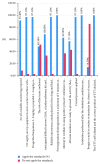Audit on Current Practice of Rapid Sequence Induction and Intubation of Anesthesia in the University of Gondar Hospital, Northwest Ethiopia, 2018
- PMID: 31662743
- PMCID: PMC6778896
- DOI: 10.1155/2019/6842092
Audit on Current Practice of Rapid Sequence Induction and Intubation of Anesthesia in the University of Gondar Hospital, Northwest Ethiopia, 2018
Abstract
Background: In patients who are liable to the risk of pulmonary aspiration, airway control is the primary and first concern for the anesthetists both in emergency and elective surgical procedures. Rapid sequence induction is universally required in any occasion of emergent endotracheal intubation needed for unfasted patients or patients' fasting status is unknown.
Methods: institutional-based prospective observational study was conducted from December 2017 to January 2018 in all elective and emergency adult or pediatric patients with a risk of pulmonary aspiration who were operated under general anesthesia with rapid sequence induction and intubation during the audit period.
Result: A total of 35 patients were operated during the study period. Of these, 31 (88.57%) patients were adults and 4 (11.43%) patients were pediatrics. Most of the patients were emergency (29 (82.857%)), and the rest were elective (6 (17.142%)).
Conclusion: Most anesthetists were good at preparing all available monitoring and drugs, making sure that IV line is well-functioning, preparing suction with a suction machine, preoxygenation, application of cricoid pressure, and checking the position of the ETT after intubation was performed. Preparing difficult airway equipment during planning of rapid sequence induction and intubation, giving roles and told to proceed their assigned role for the team, attempt to ventilate with a small tidal volume, and routine use of bougie or stylet to increase the chance of success of intubation needed improvement.
Copyright © 2019 Mamaru Mollalign et al.
Conflict of interest statement
The authors declare that there are no conflicts of interest.
Figures
Similar articles
-
Techniques of rapid sequence induction and intubation at a university teaching hospital.World J Emerg Med. 2014;5(2):107-11. doi: 10.5847/wjem.j.issn.1920-8642.2014.02.005. World J Emerg Med. 2014. PMID: 25215158 Free PMC article.
-
Effect of Use of a Bougie vs Endotracheal Tube and Stylet on First-Attempt Intubation Success Among Patients With Difficult Airways Undergoing Emergency Intubation: A Randomized Clinical Trial.JAMA. 2018 Jun 5;319(21):2179-2189. doi: 10.1001/jama.2018.6496. JAMA. 2018. PMID: 29800096 Free PMC article. Clinical Trial.
-
The incidence of oxygen desaturation during rapid sequence induction and intubation.World J Emerg Med. 2014;5(4):279-85. doi: 10.5847/wjem.j.issn.1920-8642.2014.04.007. World J Emerg Med. 2014. PMID: 25548602 Free PMC article.
-
[Rapid sequence induction and intubation in patients with risk of aspiration : Recommendations for action for practical management of anesthesia].Anaesthesist. 2018 Aug;67(8):568-583. doi: 10.1007/s00101-018-0460-3. Epub 2018 Jun 29. Anaesthesist. 2018. PMID: 29959498 German.
-
[Emergency anesthesia, airway management and ventilation in major trauma. Background and key messages of the interdisciplinary S3 guidelines for major trauma patients].Anaesthesist. 2011 Nov;60(11):1027-40. doi: 10.1007/s00101-011-1957-1. Anaesthesist. 2011. PMID: 22089890 Review. German.
References
-
- Sinclair R. C., Luxton M. C. Rapid sequence induction. Continuing Education in Anaesthesia Critical Care & Pain. 2005;5(2):45–48. doi: 10.1093/bjaceaccp/mki016. - DOI
LinkOut - more resources
Full Text Sources


